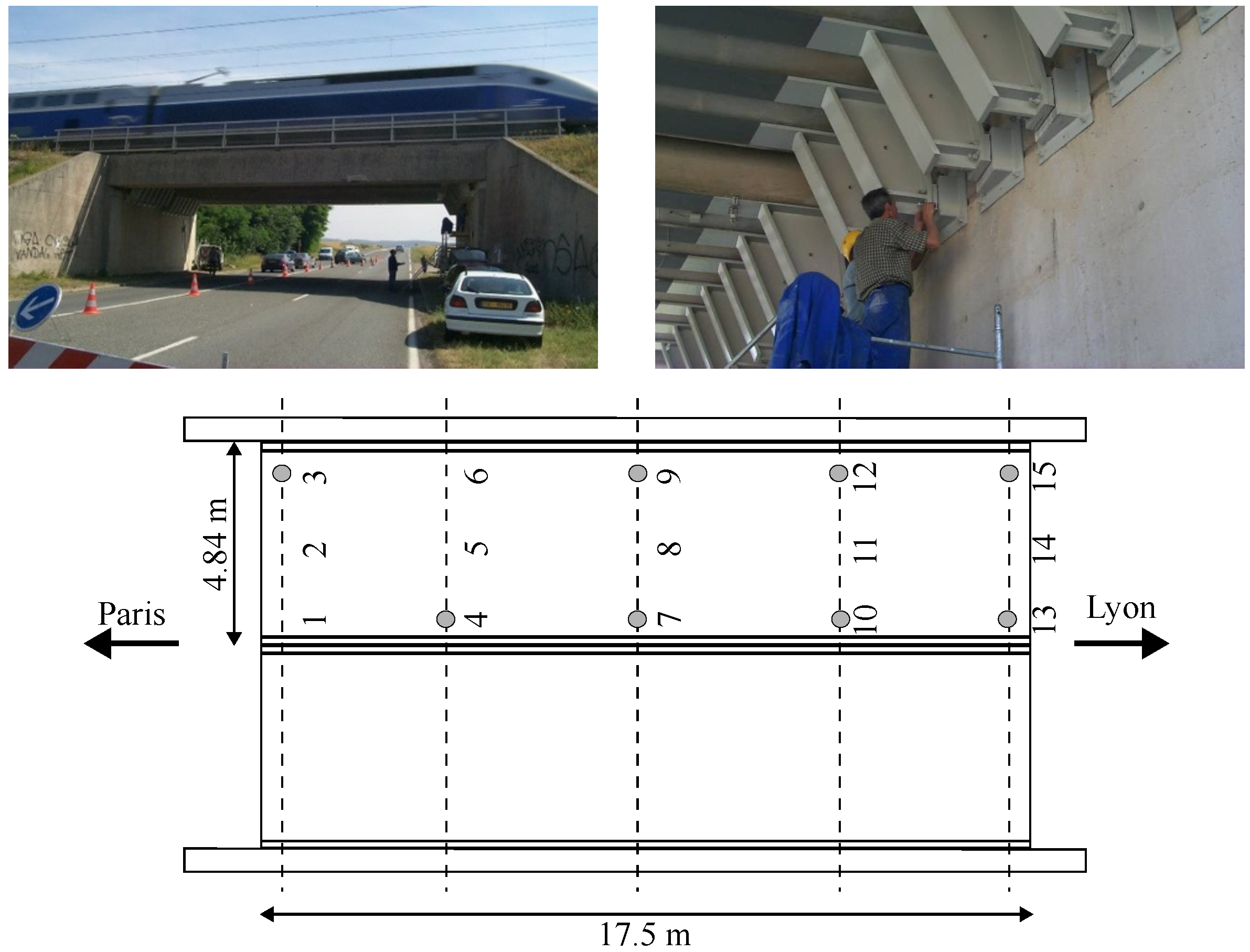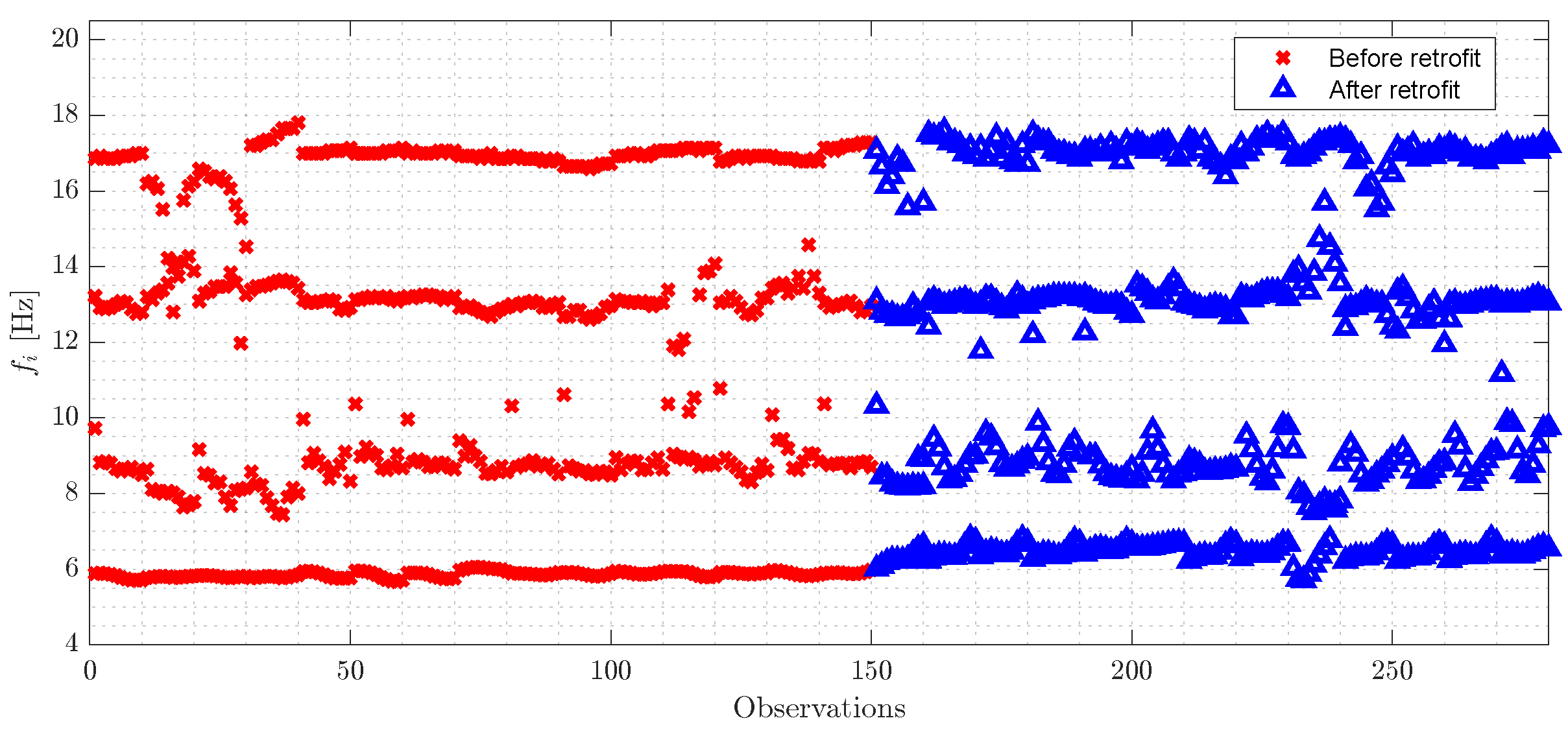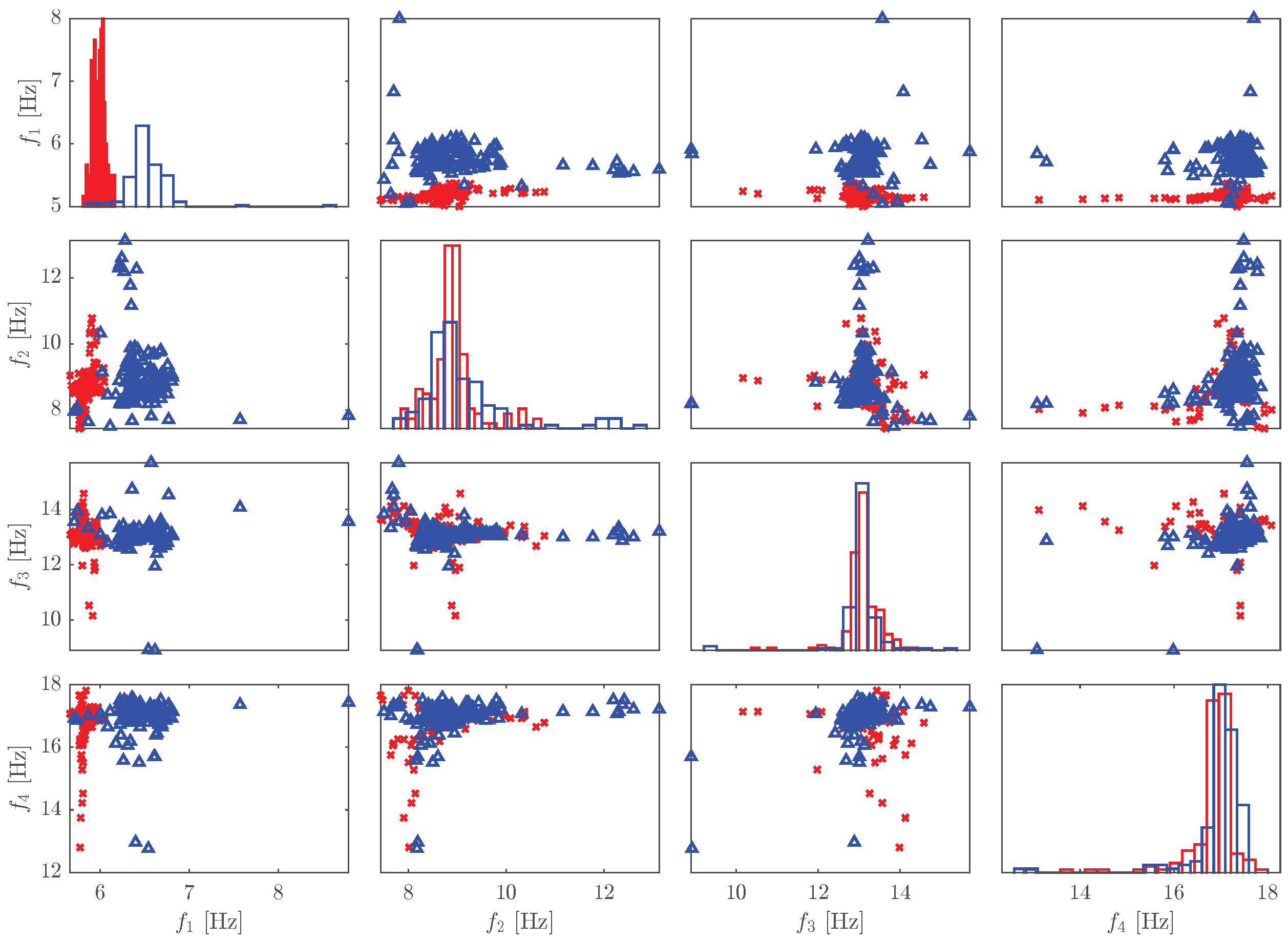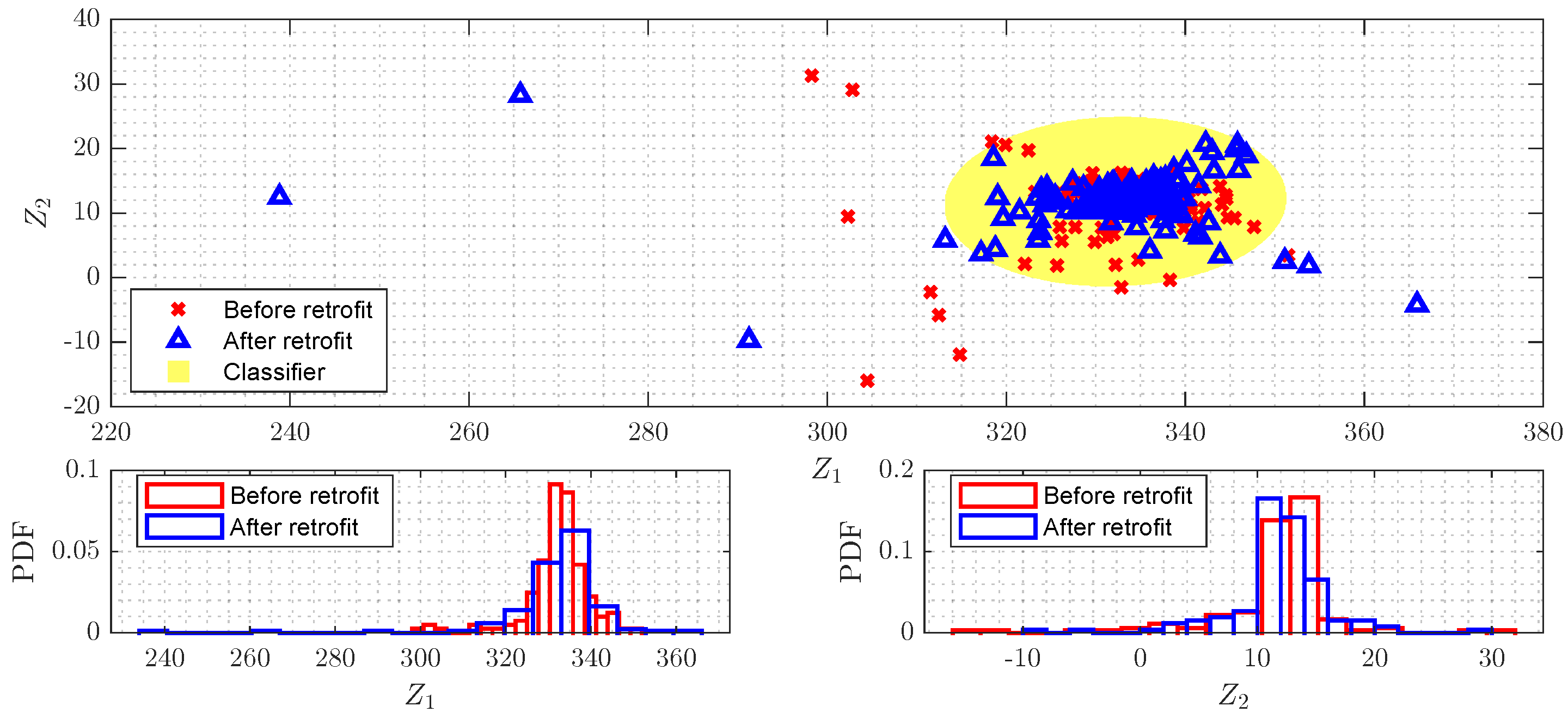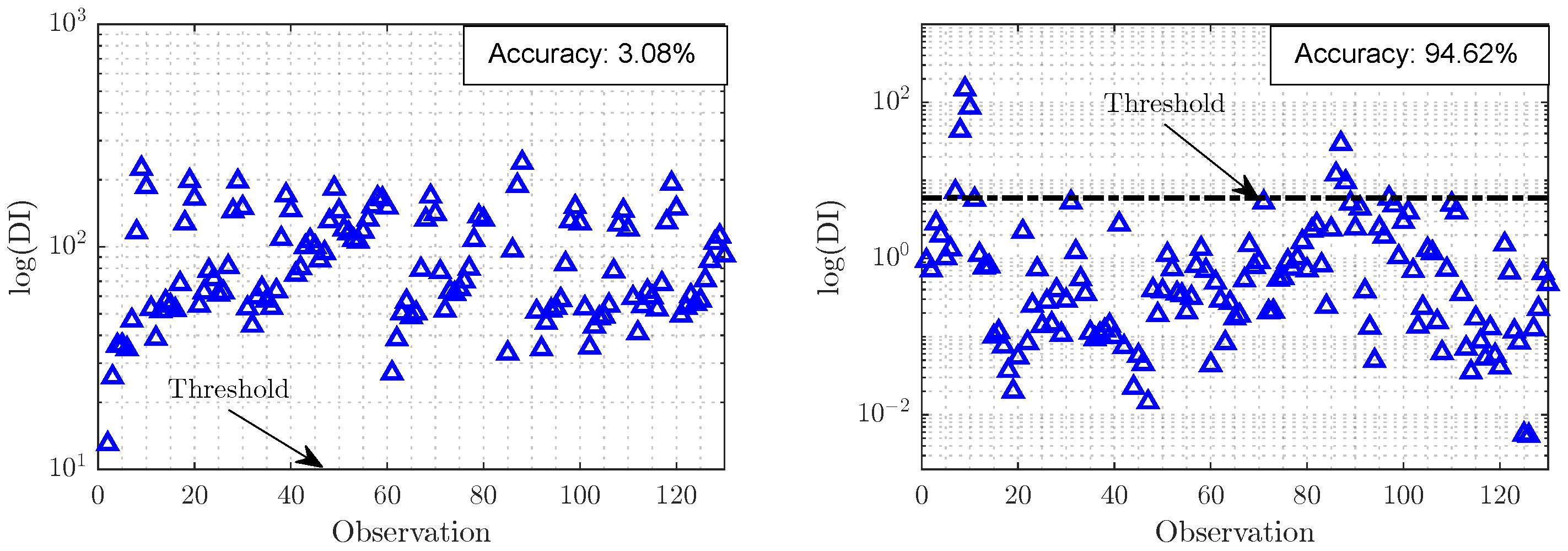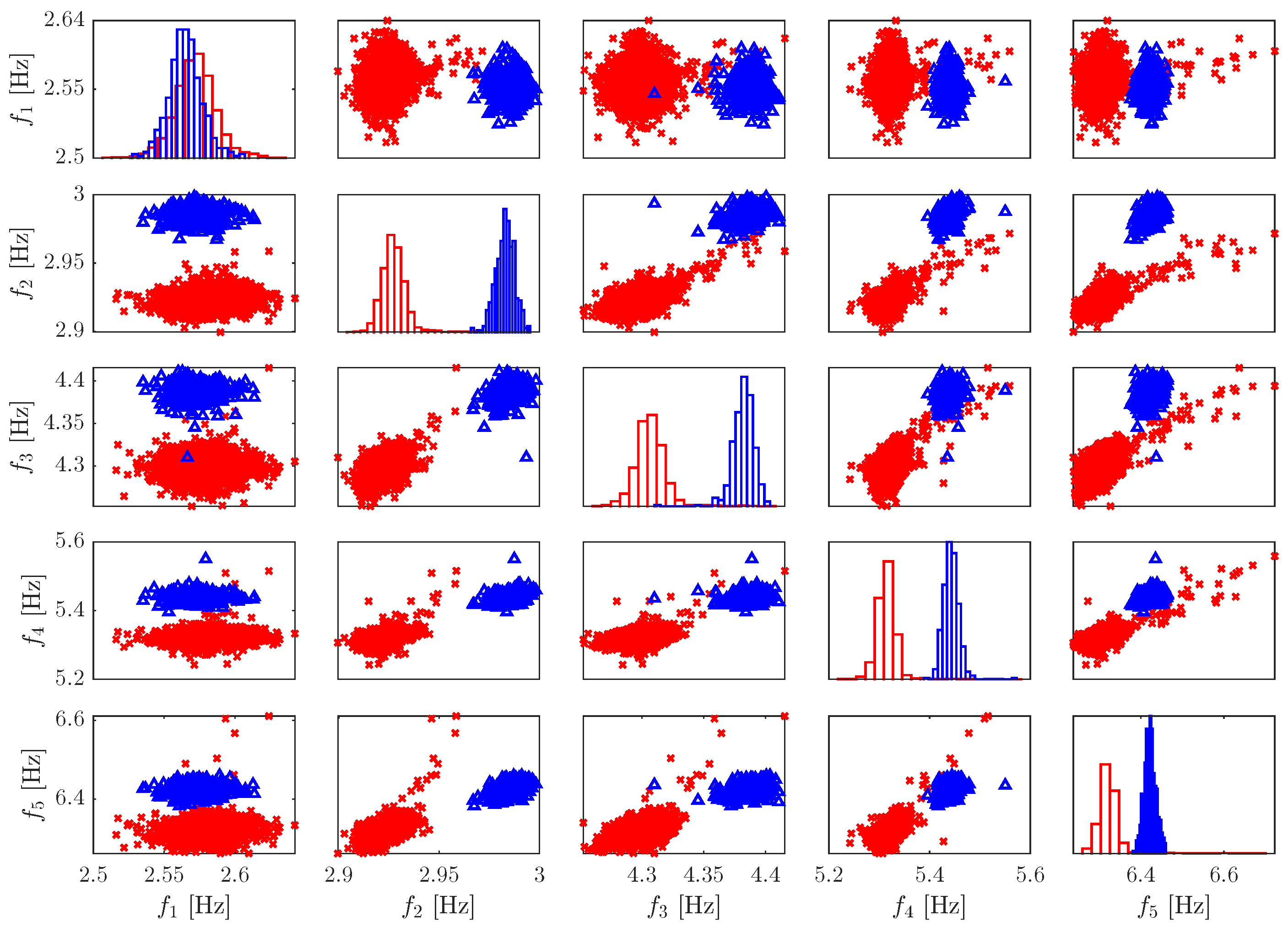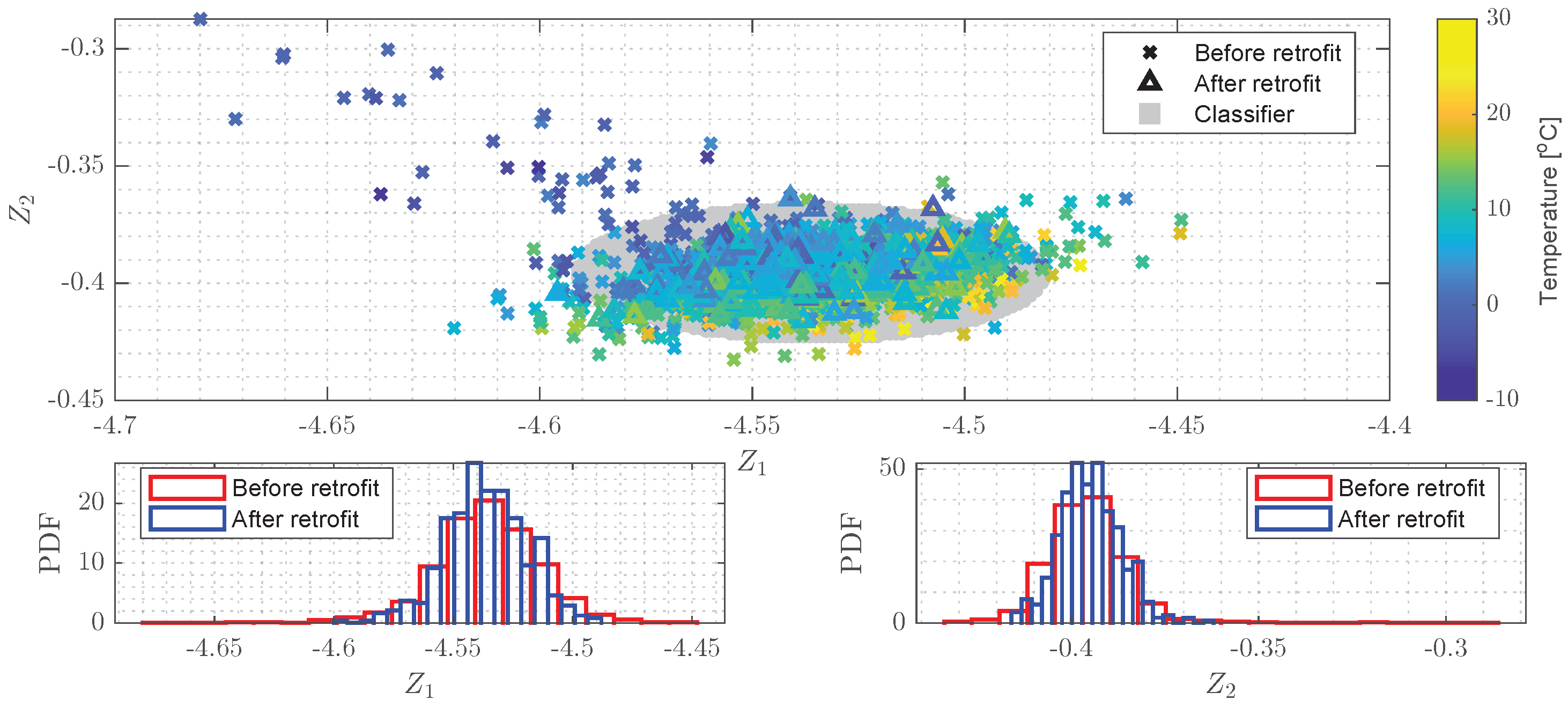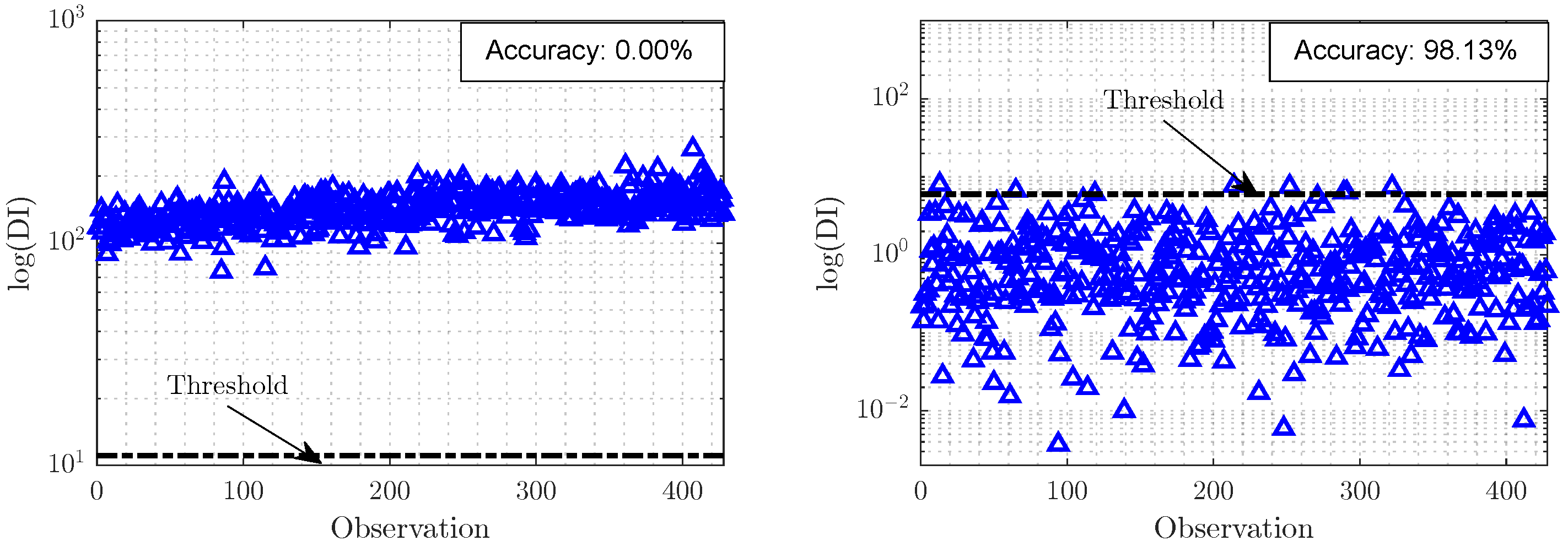1. Introduction
The construction of bridges aims to meet the socioeconomic needs of several human generations, as these structures are engineered to last more than 100 years. However, the service requirements of bridges are prone to change over their lifetime, and the effects of accumulated degradation over the years may result in the need for a retrofit process. In the context of bridge engineering, retrofitting refers to strengthening components after an evaluation structural strength and stiffness of bridge elements to extend their lifespan, ensuring a safe operation as a result of restoring its structural integrity [
1].
The retrofit process is often associated with variations in the modal parameters of the bridge due to the structure’s stiffness increase, mainly noticed in the natural frequencies. For instance, a highway bridge in Singapore underwent a retrofit process in 2003, and some components were replaced, leading to a variation in natural frequencies up to
while their vibration modes did not show significant changes [
2]. The rehabilitation of a concrete bridge located in Italy by replacing the external layer of the pillars with a fiber-reinforced concrete material and steel rebars represents another example of a retrofit process, which restored the material properties of the bridge’s component while preserving its cross-sectional dimensions [
3].
In the last decades, structural health monitoring (SHM) has been proposed to support decision-making by bridge owners and authorities [
4,
5]. The long-term damage detection process often relies on machine learning algorithms to build unsupervised classifiers. An analysis based on unsupervised learning has been the priority as it is not feasible to introduce real damage to bridges due to their high cost and potential safety risks of operating the structures under a damaged condition.
The practical application of machine learning algorithms is not always feasible, as training and test datasets may not share similar underlying distributions due to several reasons [
6]. This assumption limits the application of these algorithms to the specific structure they were trained for. For instance, a classifier trained with datasets before retrofit may not be accurate as the new observations obtained after retrofitting may not share the same underlying distribution due to structural changes. Therefore, how can the knowledge contained in the long-term monitoring data of a bridge be generalized to the same bridge after retrofitting? Transfer learning in the context of domain adaptation represents a promising solution in the SHM of bridges, including those bridges that underwent retrofitting. In recent years, the application of transfer learning has received significant attention in bridge SHM [
7]. The main idea is to benefit from the existing knowledge of a monitored structure to evaluate another without estimating a new model or classifier.
The traditional analysis assumes the existence of two bridges with unbalanced datasets, i.e., the historical data of the source bridge is well-known, and the target bridge has a reduced amount of datasets. Then, feature-based transfer learning aims to find a new subspace where observations from two bridges in the undamaged condition are properly aligned, as changes in the structural framework of the target bridge often shift the observations. Thus, classifiers trained on a known structure (source) can be generalized to other bridges (target) where there is not enough knowledge about their structural condition [
8].
Poole et al. [
9] proposed a study on the structural behavior of several bridges, using a normal-correlation alignment method to evaluate features during undamaged conditions. Their approach succeeded in generalizing a classifier for structural evaluation. Specifically, under comparable structural conditions, outliers were highlighted when the features indicated different structural states. Meanwhile, Pan et al. [
10] introduced a deep learning model to address the structural damage detection by transferring knowledge between two distinct bridges. A convolutional neural network, which was pretrained using the data of a previously studied bridge, was repurposed to evaluate another bridge’s structural integrity. This strategy reduced the need for extensive labeled data during the training phase and avoided re-estimating the model’s hyperparameters.
This paper proposes transfer learning as a domain adaptation to mitigate the data divergences for the same bridge before and after retrofit, allowing one to reuse previously existing knowledge in a long-term damage detection process. The joint distribution adaptation (JDA) method is carried out using datasets from two railway bridges: the PK 075+317 Bridge in France [
11] and the KW51 Bridge in Leuven, Belgium [
12]. The authors believe that the retrofit process is one of the most effective uses of SHM and the knowledge contained in the datasets can be reused for the structural assessment of bridges. It is important to note that our aim in this paper is distinct from Poole et al. [
9], as knowledge transfer is performed between different moments in time of the same structure.
The structure of this paper is as follows; besides
Section 1, the concept of transfer learning is introduced, and a long-term damage detection strategy using domain adaptation in retrofitting is summarize in
Section 2. The subsequent
Section 3 and
Section 4—highlight the application of our proposed methodology in two distinct real bridges as case studies.
Section 5 gives a summary of our findings, providing a conclusion and pertinent remarks on our study.
2. Transfer Learning for Long-Term Outlier Detection in the Context of Bridge Retrofitting
2.1. Overview of Transfer Learning for SHM
Transfer learning (or knowledge transfer) can described by the relationship between domains and tasks [
13]. Each domain (
) is represented by a feature space (
) comprising damage-sensitive features grouped in the form of observations (
) obtained from the structures with their corresponding probability distributions (
). The predictive function
applied for the assessment of the structure along with the label space (
) composed of information about the structural condition represents the task (
) [
14].
The definition of transfer learning leverages the knowledge contained in measured datasets despite the inconsistencies between domains (
) and tasks
). This assumption allow us to use prior knowledge about the source domain (
) and source task (
) to aid in the evaluation of the target domain (
), improving the performance of the target predictive function (
) consequently [
15]. Meanwhile, domain adaptation is a subfield of transfer learning that mainly addresses the differences between the probability distributions (
), while their domains and tasks are equivalent (
and
) [
16].
In the context of bridge SHM, the knowledge about structural conditions present in datasets of a known bridge is applied for long-term damage detection in a different bridge. For a successful knowledge transfer between different structures, the bridges should present similarities that motivate the realization of the transfer, an equivalent structural dynamic behavior, for instance.
2.2. Proposed Methodology for Domain Adaptation and Feature Classification
A novel application of transfer learning through domain adaptation is proposed to reuse the knowledge from a bridge before its retrofit to evaluate its structural condition after the retrofit process, assuming the existence of no damage before retrofitting.
As the modal parameters are sensitive to changes in stiffness, the natural frequencies are herein used as damage-sensitive features. The idea is that despite the consequent variations in natural frequencies caused by retrofitting, the historical monitoring data of a given bridge measured before retrofitting can be reused to aid in analyzing its structural integrity after retrofitting.
Figure 1 presents an overview of the methodology proposed in this paper. A bridge in its initial condition (source domain) and after retrofitting (target domain) have their natural frequencies estimated through a monitoring system. In the original feature space, it is assumed the existence of an evident change in the frequencies caused by changes in stiffness after the retrofit is assumed, which directly correlated with changes in the structural dynamic behavior. Afterwards, transfer learning via a domain adaptation method is applied to map features to a subspace where their divergences are mitigated (latent feature space). In this case, the JDA method is applied to estimate a transformation matrix that maps the observations to the latent space.
An outlier damage detection process is performed based on the Mahalanobis squared distance (MSD) [
17,
18], which is estimated in the original and latent spaces using the source knowledge only and assuming an underlying multivariate Gaussian distribution. The classifier’s performance is evaluated through its accuracy before and after the JDA application. The main idea is to build a classifier capable of correctly evaluating the structural condition through an outlier detection classification despite completing the retrofit process.
2.3. Joint Distribution Adaptation (JDA)
The JDA method [
19] proposes a mapping function (
) to project the features to a reproducing kernel Hilbert space, where the differences between the joint distributions are mitigated. This often nonlinear mapping function adapts the marginal distributions (
) and the class-conditional distributions (
) with classes
), allowing the generalization of model/classifier to different structures as a consequence.
Note that the class-conditional distribution is analyzed instead of the conditional distribution. This is a consequence of the lack of knowledge about the labels in the target domain. To address this issue, a base classifier trained with the source knowledge is applied iteratively for the determination of the target pseudo-labels, providing the optimization of the mapping function for the projection of the features as the classifier’s performance improves [
20].
A kernel-based distance metric, called maximum mean discrepancy, is applied to evaluate the divergences between the source and target domains. This statistical distance metric measures the average distance between the probability distributions of the features after their embedding through a kernel matrix (
), which avoids the explicit determination of the mapping function [
21]. The squared maximum mean discrepancy (
) can be written as:
where
matrix contains the weights applied to perform the feature transformation into a latent space, and
is the trace function. In addition, the
matrix can be described as:
where
refers to source features of class
c based on their corresponding labels, and
refers to target features given the class
c determined according to their respective pseudo-labels.
It is important to preserve the underlying properties of the features after their mapping to the shared latent space. This constraint can be described by the data variance
), where
H is the centering matrix. Hence, this minimization problem with one constraint to be satisfied can be written as:
where
is the identity matrix and
is the trade-off parameter. Note that the first term corresponds to the objective function that measures the distance between the joint distributions, and the regularization term described by the second term avoids a possible overfitting. The Lagrange multipliers can be applied to address this minimization problem, resulting into an eigenproblem defined by:
where
represents the transformation matrix defined by the
m smallest eigenvectors, and it is applied with the kernel matrix for the features mapping to the latent space through
.
2.4. Classifier: Mahalanobis Squared Distance (MSD)
The MSD is a distance metric for multivariate statistics often applied for outlier detection in SHM analysis [
22,
23,
24]. The traditional methodology estimate the multivariate mean vector
and the covariance matrix
of the training data from the source domain
. The evaluation of the test data composed by the new observations from the target domain
investigates whether their patterns differ significantly, indicating structural damage by the presence of outliers. By definition, the MSD or damage index (DI) can be written as [
17]:
In this analysis, a hypothesis test is proposed to ensure the statistical reliability of the structural integrity assessment. Thus, the probability density function of the DIs is investigated if the null or alternative hypotheses are met according to an established threshold value. Formally, the null hypothesis is assumed when the structure is in a healthy condition, while the alternative hypothesis indicates the presence of structural damage.
In the healthy condition, it is assumed that each observation belongs to a Chi-squared distribution
by definition, i.e.,
[
25,
26]. Then, it becomes possible to set a threshold value
in agreement with a level of significance
in the form of
. Therefore, an observation is defined as damaged when its DI equals or exceeds the threshold value, consequently rejecting the null hypothesis. The level of significance is often set to
, and this value is assumed herein during the analysis.
The transfer learning performance can be evaluated using the overall accuracy of the distance-based classifier estimated. A binary classification is applied in this case, assuming the damaged structural condition is positive while the undamaged condition is negative. Therefore, the accuracy of the classifier can be defined as:
where
and
represent the number of true positive and true negative when damaged and undamaged conditions are correctly addressed by the classifier, respectively. Meanwhile,
is the number of false positive and
is the number of false negative, which are also known as Type I (
) and Type II (
) errors.
4. The KW51 Bridge
4.1. Structural Description and Monitoring Datasets
The KW51 Bridge (
Figure 7) is a steel bowstring bridge in Leuven, Belgium, with a single span of 115 m that includes two ballasted railway tracks that connect the stations of Herent and Leuven [
12].
The bridge underwent an inspection that indicated the necessity for a retrofit plan to address a problem related to its construction. The bolted joints that connected the bridge deck and arches were strengthened by welding a steel box between the structural components to ensure the bridge’s safety and stability.
A long-term monitoring plan was carried out from 2 October 2018, to 15 January 2020, to follow the entire bridge retrofit process. A monitoring system with 12 accelerometers was installed along the bridge to measure its dynamic behavior, as well as other sensors were positioned to collect environmental parameters, including temperature and relative humidity. The datasets were collected in three periods: (i) before the bridge retrofit from 2 October 2018, to 15 May 2019; (ii) while conducting the retrofit from 15 May 2019, to 27 September 2019; and (iii) after completing the retrofit from 27 September 2019, to 15 January 2020.
An operational modal analysis was carried out to follow the evolution of the structure’s modal parameters over the monitoring process for the bridge structural assessment.
Figure 8 illustrates the 14 natural frequencies estimated in this period. Note that some frequencies are unavailable for some days due to measurement problems. Overall, it can be observed an increase in natural frequencies: (i) before retrofitting due to the effects of negative temperatures as suggested by some peaks in specific frequencies and (ii) after performing the retrofit process due to the increase of permanent stiffness.
In this study, only the bending modes of the bridge are investigated, as the most significant variations in frequencies are present in these modes. Therefore,
Table 2 provides an overview of the average of five natural frequencies before and after the retrofit process. A slight yet important variation in some frequencies (maximum of
) can impact the performance of machine learning algorithms, which are often sensitive to changes in the datasets used in the training phase.
Figure 9 illustrates the natural frequencies in the original space and their corresponding histograms of the bridge before and after its retrofit. On the main diagonal, the histograms highlight the differences between the features extracted from the bridge datasets. In a two-dimensional perspective, the features are not aligned due to frequency variations, and some apparent outliers are present, indicating possible impacts caused by the temperature and by the bridge structural condition that motivated the retrofit.
4.2. Outlier Detection and Structural Assessment
The general concept of transfer learning that preserves a higher proportion of observations from the source domain compared to the target domain is ensured in this analysis, despite the measurement problems that prevented the use of all estimated modes. Therefore, the datasets collected before the retrofit (source domain) have 2582 observations, while the datasets after the retrofit (target domain) have 428 observations.
The JDA method is applied for domain adaptation assuming a linear kernel and the regularization parameter (
) is set to be
.
Figure 10 shows the observations in the latent feature space and the decision boundary (threshold) defined by a superimposed Gaussian distribution estimated using the source knowledge only. It is possible to observe that the divergences between the observations from the source and target domains were mitigated in the latent space. The overlap of their histograms indicates the same behavior. The source observations present some outliers in the latent space, evidencing the JDA method preserved the data properties after the features mapping to the latent space.
By assuming the presence of outliers could be associated with the presence of damage,
Figure 11 presents the DIs estimated by the classifier and its performance in the original and latent feature spaces using the observations from the target domain (after retrofit). Both classifiers were defined with observations from the source domain only (before retrofit). In the original space, the divergences between the observations do not allow a correct evaluation performed by the classifier, which is highlighted by higher values of DIs than the threshold defined for a level of significance of
. In contrast, the distance-based classifier presents a significant improvement in its performance in the latent feature space, as it could assess the bridge’s structural condition with an accuracy equal to 98.13%, which proves the classifier’s ability to be applied in future decision-making on the bridge condition.
5. Conclusions
The shifts in the damage-sensitive features induced by the retrofit process may challenge the application of long-term damage detection strategies in bridges, as machine learning algorithms may not properly describe structural-related changes in the features occur after the training phase. In a traditional bridge evaluation, the structural knowledge contained in the datasets before retrofitting would not be leveraged in future decision-making on the bridge’s condition, and identifying a new classifier to describe the behavior of the bridge would be necessary.
The possibility of applying transfer learning to assess the structural condition of the PK 075+317 Bridge and KW51 Bridge after the retrofit process was highlighted in this paper. In both cases, possible structural problems justified the retrofitting of the bridge components. The classification in the PK 075+317 Bridge shows an overall accuracy gain from to after the JDA application. Meanwhile, transfre learning significantly improved the overall classifier accuracy from to in the KW51 Bridge in Leuven.
Even though the data mapping onto the latent feature space may be challenging to interpret the physical phenomena, the proposed methodology rooted in transfer learning and domain adaptation has the advantage of aligning the monitoring datasets measured before and after retrofitting while keeping their statistical properties. Thus, transfer learning can also be applied to describe the dynamics behavior of structures under retrofit conditions in a lower dimensional space, offering a novel perspective for overcoming monitoring data mismatch in the damage detection process when a bridge is retrofitted.

